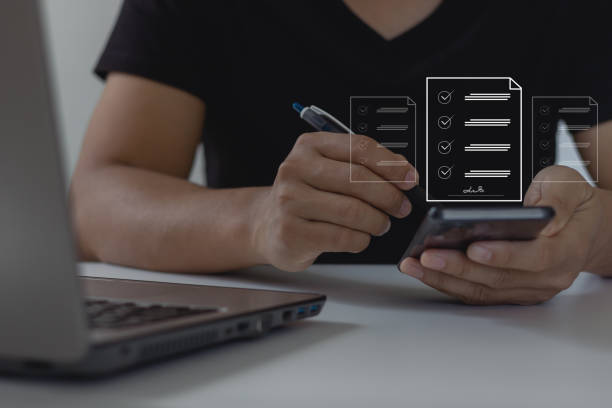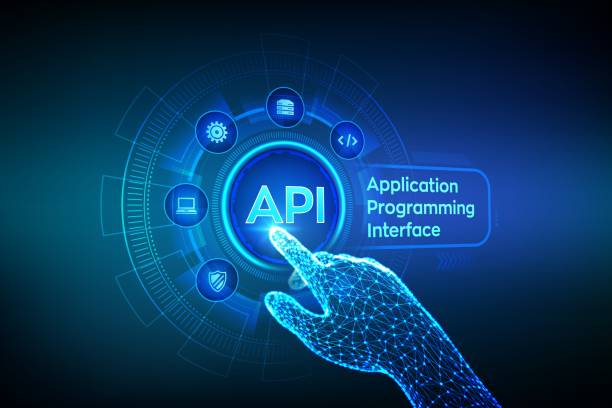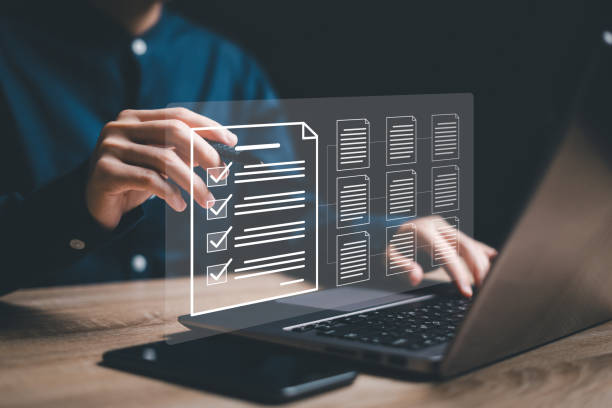What is On-page SEO and Why is it Crucial for Your Website?
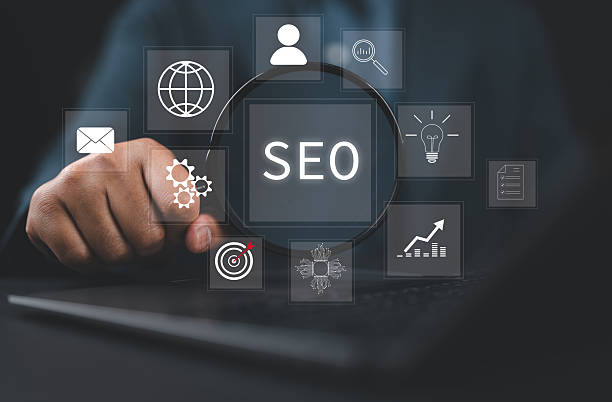
In today’s highly competitive world, a deep understanding of #on_page_seo or On-Page SEO is crucial for any website looking to gain visibility and attract an audience.
This educational and explanatory section shows you that on-page SEO is not just about keyword stuffing, but a set of targeted actions performed within your website to optimize it for both search engines and users.
The primary goal of on-page SEO is to send clear signals to search engines about the topic, quality, and relevance of your content.
This helps Google’s algorithms better understand your pages and assign them appropriate rankings in search results.
Without strong on-page SEO, even with the best content, your website might get lost among a flood of information.
This process includes optimizing titles, meta descriptions, URL structure, text content, images, and internal linking, all of which contribute to increased visibility and organic traffic acquisition.
Understanding these basic concepts is essential for every SEO specialist or website owner.
On-page SEO, in its precise meaning, refers to all actions you perform within your website’s pages to improve their ranking in search engine results.
This includes elements visible to users as well as codes readable only by search engines.
The importance of this issue can be highlighted by the fact that your content, no matter how high-quality, might never reach its target audience without proper optimization.
Internal optimization sends strong signals to search engines that your content is worth showing.
This process also helps improve user experience; well-optimized pages are usually more structured and readable.
Remember that SEO success is a continuous process, and on-page SEO is considered the backbone of this success.
Therefore, investing time and energy in this aspect of SEO will bring lasting results for your website.
Are you losing business opportunities because of an outdated website? With Rasawwb, permanently solve the problem of not attracting potential customers through your website!
✅ Attract more high-quality leads
✅ Increase brand credibility in the eyes of customers
⚡ Get free corporate website design consultation
Keyword Research: The Core of On-page SEO
![]()
#Keyword_research is the cornerstone of any successful on-page SEO strategy.
This analytical and guidance process helps you precisely understand what your target audience is searching for.
Without identifying the right keywords, all your internal optimization efforts might be fruitless.
Keyword research is not just about finding high-volume keywords; it’s about understanding user intent and finding phrases that are most relevant to your content and services.
This includes both short-tail and long-tail keywords, each playing a different role in your SEO strategy.
Longer keywords often have less competition and higher conversion rates because they indicate user intent more precisely.
To conduct effective keyword research, you can use various tools such as Google Keyword Planner, Ahrefs, or Semrush.
These tools help you identify search volume, competition, and related keywords.
After identifying your primary keywords, you should naturally incorporate them into your content, titles, meta descriptions, URLs, and H1 to H6 tags.
However, remember that keyword density alone is not important; content quality and the value provided to the user take precedence.
Search engines have become increasingly smarter and can distinguish natural, high-quality content from keyword-stuffed content.
Therefore, by focusing on engaging content and addressing real user needs, you can achieve better on-page SEO results and attract more targeted traffic to your website.
Content Optimization: On-page SEO Techniques for More Engagement

Content #optimization is one of the most important pillars of on-page SEO.
This specialized and explanatory section is not just about placing keywords in the text, but also includes your content’s structure, readability, and overall value.
High-quality, unique, and relevant content can keep users on your site longer and reduce bounce rate, which is a positive signal for search engines.
Producing long and comprehensive content (such as 1000-2000 word articles) that thoroughly covers a topic typically performs better in rankings.
This type of content not only provides more value to users but also offers more opportunities to include relevant and diverse keywords.
One effective approach to content optimization is the use of LSI (Latent Semantic Indexing) keywords.
These words are synonyms and related phrases that help search engines better understand the main topic of your content.
Using headings (H1, H2, H3, etc.) is essential for organizing content and improving readability for both users and search engines.
Additionally, using lists, tables, and quotes can make content more engaging and easier to digest.
Below is an example table for evaluating good content factors for on-page SEO:
| Factor | Explanation of Importance in On-page SEO |
|---|---|
| Primary and Secondary Keywords | Ensuring natural and relevant inclusion of target keywords throughout the text. |
| Heading Structure (H1-H6) | Logical organization of content for better readability and topic comprehension by bots. |
| Content Length | Comprehensive and in-depth content usually achieves a better ranking. |
| Readability | Using short sentences, small paragraphs, and simple language. |
| Freshness and Uniqueness | New and original content is preferred over duplicate content. |
One of the key guidelines is to always think about your users.
Produce content that truly answers their questions, solves their problems, or provides them with useful information.
This approach not only helps your on-page SEO but also leads to building credibility and trust among your audience.
Regularly updating old content and adding new information can also help improve your rankings.
Title Tags and Meta Descriptions: Gateways to Your Site
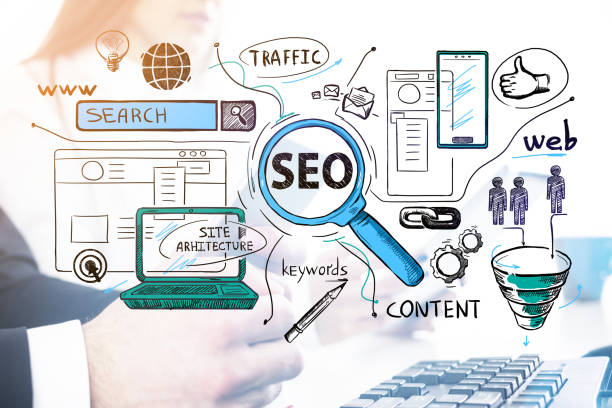
The #title_tag (Title Tag) and #meta_description (Meta Description) are the first things users see in search results, and as such, they play a vital role in attracting clicks and improving on-page SEO.
These two elements act like a business card for your page.
An attractive and relevant title can significantly increase your click-through rate (CTR), even if you’re not at a high rank.
The title should include the page’s main keyword and clearly indicate what the page’s content is about.
The ideal length for a title tag is between 50 to 60 characters to be fully displayed in search results.
This is an important educational aspect that is often overlooked.
Meta descriptions, although not directly affecting ranking, have a significant impact on click-through rates.
An attractive and compelling meta description can encourage users to click on your link.
Meta descriptions should be a brief summary (typically between 150 to 160 characters) of the page’s content, include the main keyword, and have a call-to-action (CTA) that encourages users to visit the page.
For example, the phrase “Learn how to best implement on-page SEO!” can be very effective.
Search engines may not always use your meta description and sometimes generate a summary of the content themselves based on user searches, but providing an optimized meta description is always a guiding and smart action for on-page SEO.
Ensure that each page has a unique and optimized title tag and meta description to avoid duplicate content penalties.
Are you bothered by losing customers who visited your site to make a purchase?
Rasawwb is your specialized solution for having a successful online store.
✅ Significant increase in your online sales
✅ Building trust and professional branding with customers⚡ Get free consultation from Rasawwb specialists now!
URL Structure and Internal Linking: Pillars of Successful On-page SEO
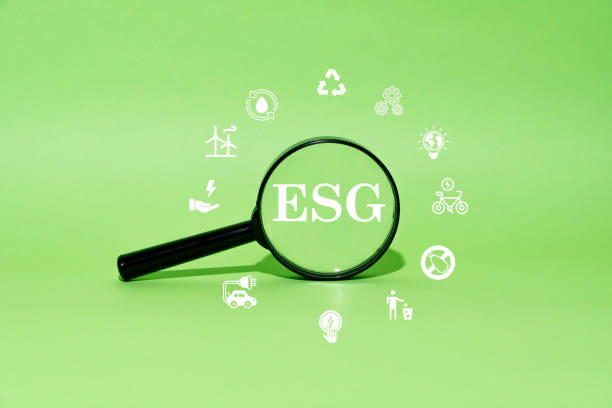
#URL_structure and #internal_linking are two key and often overlooked factors in a successful on-page SEO strategy.
A clean, short, and descriptive URL structure is not only easier for users to understand but also helps search engines better comprehend the page’s topic.
URLs should include main keywords and avoid special characters and unnecessary numbers.
Using hyphens (-) to separate words instead of underscores (_) is recommended, as search engines interpret hyphens as word separators.
This is a technical tip that helps optimize crawlability.
Internal linking is equally important.
Internal links are links that connect different pages within your website to each other.
This is crucial for on-page SEO for two main reasons: first, it helps search engines find and index all your pages, gaining a better understanding of your website’s structure and hierarchy.
Second, it distributes authority and “Link Equity” (Link Equity) throughout your website.
When an authoritative page links to another page, it passes a portion of its authority to that page, helping to improve its ranking.
For example, linking from a highly visited article to a relevant product, can help that product’s ranking in searches.
Using relevant and descriptive anchor texts (Anchor Text) in internal links, informs both search engines and users what the destination page is about.
This process is an important explanatory element for increasing the efficiency of on-page SEO.
A strong internal linking strategy can significantly improve your user experience and SEO performance.
Image Optimization and Page Load Speed: Enhancing On-page SEO Efficiency
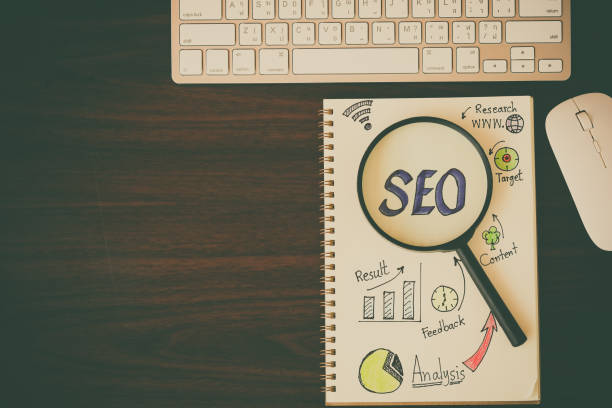
Alongside text content, #image_optimization and #website_load_speed also play a significant role in enhancing on-page SEO and improving user experience.
Engaging images can enrich your content and make it more enjoyable, but if not properly optimized, they can severely slow down your site.
To optimize images, first reduce their file size as much as possible without sacrificing visual quality.
Use modern image formats like WebP, which offer better compression.
Additionally, using ALT tags (Alt Text) for every image is essential.
ALT tags help search engines understand the image content, as they cannot visually “see” images.
The ALT tag should be descriptive and include relevant keywords.
This is an important guidance point for improving accessibility and image SEO.
Website load speed is one of Google’s important ranking factors and has a direct impact on user experience.
Today’s users expect websites to load quickly, and if your site is slow, they are likely to leave.
This increased bounce rate sends a negative signal to search engines.
To improve site speed, in addition to image optimization, you can use Gzip compression, browser caching, reducing the number of HTTP requests, using a CDN (Content Delivery Network), and optimizing CSS and JavaScript code.
Tools like Google PageSpeed Insights and GTmetrix can help you with a precise analysis of site speed performance and problem identification.
Improving load speed not only benefits on-page SEO but also directly helps increase user satisfaction and conversion rates.
Technical Factors and Schema Markup: Advancing On-page SEO
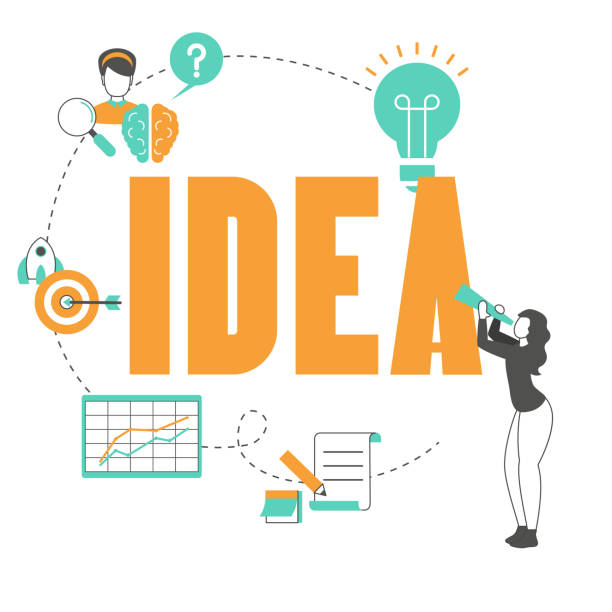
Alongside content and structure, #technical factors and #schema markup implementation play a very important role in enhancing your website’s on-page SEO.
Technical SEO involves examining and optimizing your website’s technical infrastructure to improve crawlability and indexing by search engines.
This includes items such as robots.txt file, XML sitemap, 404 error management, and canonical tags.
Each of these elements helps search engines crawl your website more efficiently and correctly index the right content.
The news of continuous updates to Google’s algorithms has doubled the importance of technical SEO.
Schema Markup, also known as structured data, is a type of microdata that you can add to your website’s HTML to enable search engines to better understand your content.
This data helps search engines understand specific information such as user reviews, product prices, recipes, or events, and display them as “Rich Snippets” (Rich Snippets) in search results.
The display of Rich Snippets can significantly increase your click-through rate, as it makes your page more prominent in search results.
Below is a table for common types of schema markup and their uses:
| Schema Type | Application | Example Usage |
|---|---|---|
| Article | News articles, blogs, academic articles | Displaying author information, publication date in search results. |
| Product | Online store products | Displaying price, availability, customer reviews. |
| Review | Reviews and ratings | Displaying star ratings below the link in results. |
| FAQPage | Frequently asked questions pages | Displaying answers to questions as an accordion in results. |
Another important technical element is Core Web Vitals, which include LCP (Largest Contentful Paint), FID (First Input Delay), and CLS (Cumulative Layout Shift).
These metrics measure different aspects of user experience such as loading speed, interactivity, and visual stability of the page.
Improving these metrics directly impacts your on-page SEO performance, and the most specialized approach for it is using Google’s developer tools.
User Experience and Bounce Rate: Its Impact on On-page SEO

In today’s world, User Experience (UX) is no longer just a benefit, but a necessity for #on_page_seo and online success.
Search engines are increasingly focusing on user experience signals for ranking pages.
If users quickly leave your site after arriving (which is called #bounce_rate or Bounce Rate), this is a negative signal for Google, indicating that your content has not adequately met user needs.
Conversely, if users spend a significant amount of time on your site and interact with the content, this is a positive signal indicating the quality and relevance of your content.
Creating an excellent user experience includes responsive design (for mobile), easy navigation, readable and engaging content, and minimal use of intrusive pop-ups.
This is an analytical aspect that needs to be carefully examined.
To improve user experience, you can use appropriate UI/UX design that easily guides users to their goals.
Ensure that your site displays well on all devices (mobile, tablet, desktop) and has high usability.
Using readable fonts, appropriate white space, and high-quality images and videos can contribute to your site’s visual appeal.
Also, reducing bounce rate by providing relevant and valuable content, and encouraging users to interact more (e.g., through commenting, sharing, or clicking on internal links) is of high importance.
A site with a strong user experience not only keeps users satisfied but also indirectly helps improve rankings in search results and succeed in on-page SEO.
Engaging content can also help increase user dwell time on the site and reduce bounce rate.
Are you tired of losing business opportunities due to not having a professional corporate website?
Rasawwb, with its professional corporate website design, helps you:
✅ Build a powerful and reliable brand image
✅ Convert website visitors into loyal customers
⚡ Get a free consultation now!
Monitoring Tools and Performance Analysis for On-page SEO
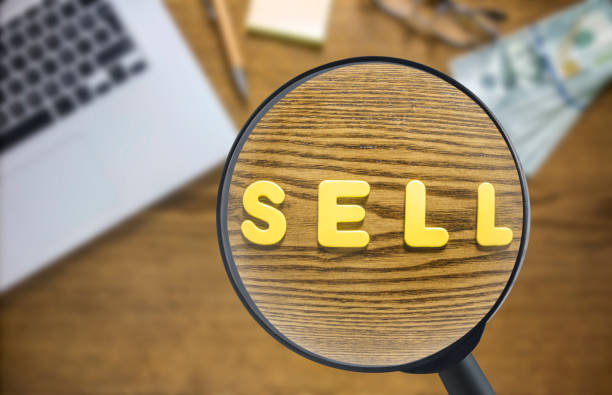
To ensure the effectiveness of your #on_page_seo strategy, using #monitoring_tools and #performance_analysis is essential.
These tools allow you to track your progress, identify potential issues, and make data-driven decisions to improve your rankings.
Google Search Console is one of the most powerful and essential free tools for any website.
This tool provides valuable information about your site’s performance in Google search results, including keywords driving traffic, crawl and indexing issues, and security errors.
Additionally, this tool is very useful for submitting sitemaps and requesting re-indexing of pages.
This is a very valuable analytical guide.
Another tool that should never be overlooked is Google Analytics.
This tool provides comprehensive information about user behavior on your site, including the number of visitors, dwell time, bounce rate, and navigation paths.
By analyzing this data, you can identify your site’s strengths and weaknesses and implement improvements to increase engagement and reduce bounce rate.
In addition to these free tools, there are also paid and more advanced tools such as Ahrefs, Semrush, and Moz Pro, which offer broader capabilities for keyword research, competitor analysis, backlink auditing, and ranking monitoring.
Smart use of these tools allows you to continuously optimize your on-page SEO strategy and remain competitive.
With these tools, an in-depth analysis of your website’s performance becomes possible, and you can pave your way to SEO success.
Advanced On-page SEO Strategies for High Competitiveness

After mastering the basics, it’s time to move on to #advanced on-page SEO #strategies to outperform competitors in highly competitive markets.
One such strategy is producing Evergreen Content (Evergreen Content).
Unlike news content, this type of content does not diminish in value or relevance over time and can bring consistent traffic to your site.
Evergreen content typically includes guide articles, tutorials, comprehensive lists, and answers to fundamental user questions that are always searched for.
This approach helps you maintain a continuous presence in search results without needing frequent updates.
This specialized aspect is crucial for SEO sustainability.
Another strategy is to focus on engaging content and in-depth content that thoroughly covers a topic and can be considered a reference.
This includes the use of Cluster Content and Pillar Pages.
In this model, a comprehensive pillar page acts as the central hub for a broad topic, and then smaller cluster pages delve deeper into specific aspects of that topic, linking back to the pillar page.
This structure not only helps organize content but also shows search engines that you have deep expertise in that area.
Optimizing for Featured Snippets and voice answers is also highly important, as these can position your website at the top of search results.
Implementing these advanced on-page SEO strategies requires a deep understanding of your audience and search engine algorithms, but the results can significantly increase your organic traffic and strengthen your position against competitors.
Are you ready to take your website’s on-page SEO to the next level?
Frequently Asked Questions
| Question | Answer |
|---|---|
| What is On-page SEO? | On-page SEO refers to a set of actions performed within your website to improve its ranking in search engine results. This includes optimizing content, site structure, and HTML code. |
| Why is On-page SEO important? | On-page SEO helps search engines understand your page’s content and determine whether your content is relevant to searchers. It is the foundation of any successful SEO strategy. |
| What are the key elements of On-page SEO? | Page title (Title Tag), Meta Description, keyword usage, image optimization, heading structure (H1, H2, …), internal linking, and content quality are key elements. |
| How to optimize the page title (Title Tag)? | The page title should include the main keyword, be attractive and encouraging for clicks, and be between 50 to 60 characters (or appropriate pixels) in length to be fully displayed in search results. |
| What role does Meta Description play in On-page SEO? | The meta description is a summary of the page’s content displayed below the title in search results. Although it does not directly affect ranking, it helps SEO by increasing the click-through rate (CTR). |
| What is the importance of using heading structure (H1, H2, H3) in On-page SEO? | Headings structure the page content and make it easier to read. H1 is usually the main title of the page and should include the keyword. H2 and H3 are used to organize sub-sections and help search engines understand the content hierarchy. |
| How to effectively use keywords in content? | Keywords should be used naturally and logically throughout the content, including the introduction, body, and conclusion. Avoid keyword stuffing. |
| What steps are involved in optimizing images for On-page SEO? | This includes compressing images to reduce file size, using descriptive file names, adding appropriate alternative text (Alt Text), and optimizing the image title and description. Alt Text is crucial for accessibility and helping search engines understand image content. |
| What is Internal Linking (Internal Linking) and what are its benefits? | Internal linking means creating links from one page on your website to another page on the same website. This helps users easily navigate your site, distributes page authority across the site, and helps search engines better understand your site’s structure. |
| What is the importance of content quality in On-page SEO? | High-quality, accurate, comprehensive, and valuable content for users, is the cornerstone of on-page SEO. Search engines prefer content that meets user needs. Quality content leads to longer user dwell time (Dwell Time) and lower bounce rate (Bounce Rate) which are positive SEO signals. |
And other services of Rasawwb Advertising Agency in the field of advertising
Smart UI/UX: A new service to increase online growth through SEO-driven content strategy.
Smart Website Development: A new service to increase sales through marketing automation.
Smart Direct Marketing: Transform user engagement with the help of SEO-driven content strategy.
Smart SEO: Transform customer behavior analysis with the help of precise audience targeting.
Smart Marketplace: A professional solution for digital branding with a focus on smart data analysis.
And over hundreds of other services in the field of online advertising, advertising consulting, and organizational solutions
Online Advertising | Advertising Strategy | Advertorial
Resources
Comprehensive Guide to On-page SEO
Methods to Increase Website Traffic
Strategic SEO Tips
Google Ranking Factors
? To shine in the online space, you need a reliable partner. Rasawwb Afarin, a leading digital marketing agency, paves your path to digital success by providing comprehensive services including SEO, smart advertising, and personal website design. Contact us today and transform your business’s future!
📍 Tehran, Mirdamad Street, Next to Central Bank, Southern Kazeroun Alley, Ramin Alley, No. 6


